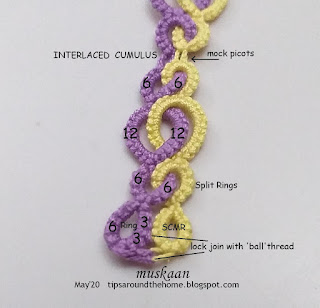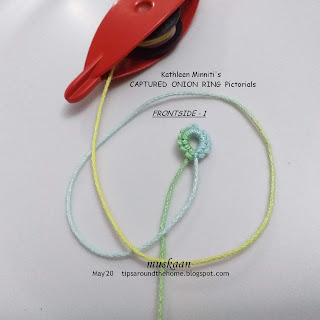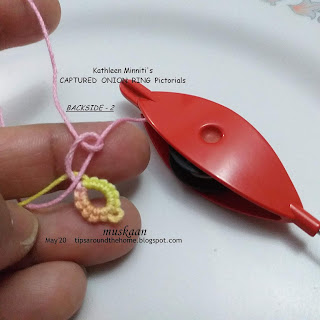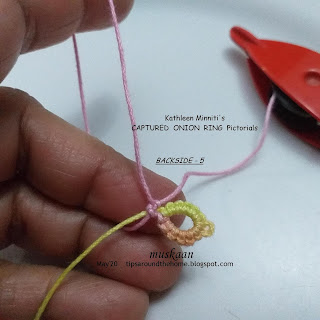So
here’s the next pattern in the same Interlacing technique (tutorial links at end of post). It reminds
me of floating cumulus clouds, especially if one uses the right colours. The
pattern changed and emerged as I tatted, with the familiar ‘what if I do this?’ dictating my hands. Hence again there is a lot of scope to adapt and change.
Interlaced
Cumulus
pattern
for braid / bracelet / earrings
4 shuttles. In the model, shuttles
1 & 2 have purple thread, ctm ; shuttles 3 & 4 have yellow thread, ctm.
TO START AND
FINISH :
Sh1: Ring : 3 – 3 -– 6.
Sh3: SCMR: 6 + 3 + 3.
Please Note : In order to maintain
colour symmetry, I used the ball thread join (or lock join with 2nd
shuttle - https://tipsaroundthehome.blogspot.com/2016/04/shuttle-2-to-rescue.html).
This is also the reason why the 2nd ring is worked as a mock ring,
so that the ‘ball’ shuttle is free to make a lock join.
This
is optional, and one can start any way you wish.
PATTERN :
Sh1: Split
Sh3: Split
Sh1: Split
Sh3: Split
Sh1: Split
Sh3: Split
This completes one
motif. Leave bare thread for mock picot and repeat for desired length.
For
Interlacing, you can choose the
movement (back to front or front to back) and corresponding effect (under/over
or over/under). In the model, the movement is alternated between motifs.
TIP: In the center, where colours are
switched, the mock picots are ‘interwoven’, though not very clear in the image.
A single motif can work great as
an earring, with proper embellishment and findings! The braid can be turned
into a bracelet, lanyard, choker, etc.
I
like this design and hope you enjoy tatting it, too. Create your own versions
and please share images! happy tatting :-))))
Interlaced SR pictorials -
https://tipsaroundthehome.blogspot.com/2020/06/interlaced-rings-pictorials-revisited.html - new, clear pictorial
https://tipsaroundthehome.blogspot.com/2020/06/interlaced-rings-pictorials-revisited.html - new, clear pictorial
update - https://tipsaroundthehome.blogspot.com/2020/06/whimsical-interlacing.html - an experimental application, with pictorial.
update https://tipsaroundthehome.blogspot.com/2020/06/forever-young.html - Peony Doily
Tutorial Links
to other techniques - https://tipsaroundthehome.blogspot.com/p/tatting-resources.html



























































